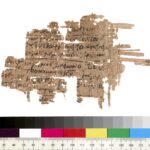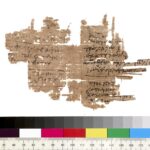| Artefact ID | 401 |
| TM ID | TM 397802 |
| Findspot (DEChriM ID) | - () | Class | Textual |
| Material | Papyrus |
| Writing medium | Sheet/roll |
| Text content | Subliterary |
| Language | Greek |
| Description | ZPE 194 (2015): 177-183 (no. 1); P.Mich. inv. 4451 a The fragment preserves parts of two columns with iatromagical text containing an invocation of the Archangels. Its content roughly resembles the christian formulary of Suppl.Mag. II 96 (5th c., Herakleopolites), and is furthermore compared by the ed.pr. to P.Oxy. XI 1384 (5th c., Oxyrhynchus) for the blend of pharmacological content and Christian apocryphal themes. The different sections of text are separated by long, horizontal lines (8 lines on the recto, 4 on the verso), similar to the lines used in P.Berl. inv. 17202. The text makes use of one nomen sacrum (for κυριοός "Lord") and two, different magical characters (recto, l. 8). The text of the recto and verso appears to be written by the same hand, and the changeable text direction between the sides indicates that the fragment is an opistograph. The ed. pr. notes that the script is irregular and slanting, and that the scribe makes substantial use of ligatures which is indicative of sub-literary hand. A kollesis is visible on the recto running down the centre of the fragment. The verso contains an invocation of "the name of the Lord" τὸ ὄνομα τοῦ κυριοῦ and three archangels (l. 8-11) which places the text within a Christian context resembling the Jewish magical tradition; see the ed. pr. The Lord's name and the Archangels (Michael, Raphael and Misael) are summoned, in combination with the taking of vinegar, as part of a treatment for dog-bites. |
| Selection criteria | Christian terms/formulas/concepts, Nomina sacra |
| Date from | 350 |
| Date to | 499 |
| Dating criteria | Palaeography. The ed. pr. dates the fragment to the 4/5 c. from comparisons with Harrauer 204 (17th of April, 344, Herakleopolites) and Harrauer 230 (20th of September, 462, Oxyrhynchus) and Heitsch XXXII (late 4/early 5th c., Mnemoneia-Djeme). |
| Absolute/relative date | Relative date |
| Archaeological context | Provenance is unknown. The papyrus was part of a lot purchased jointly by Dr. David Askren and Prof. Kelsey Boak in 1925. The ed. pr. suggests an association with the Fayûm due to the involvement of D. Askren. |
| Accession number | Ann Arbor, Michigan University, Library P. 4451 a [P.Mich.inv. 4451 a] |


 Json data
Json data





